As a quality engineer, you must know everything about PTC characteristics. Your organization may face big problem or challenges, if you are not going to identifying pass through characteristic.
This article will guide you to understand everything about pass through characteristics with real life example and challenges.
I assume that you are in Tier-1 manufacturer. You receive raw material from Supplier (Tier-2) and provides parts to OEM.

What Are Pass Through Characteristics (PTC)?
Let’s take a scenario to understand this with detail.
You are a Tier1 manufacturing company. Typically, you take some components from Tier2 supplier do some assembly operations and provide this parts to OEM customer.
Now if, one of the dimension or feature of your supplier component not ok, and you don’t have any control on it. You are not going to inspect that dimension but still this dimension affects your customer assembly.
Then in this scenario, that dimension is your PTC (Pass Through) Characteristics.
Therefore, Pass Through Characteristics (PTCs) are product or process features/dimensions that cannot be inspected or rechecked once they leave a specific stage in the manufacturing process. These characteristics are essentially a “pass through” without subsequent process steps inspection.
This condition makes them highly sensitive from a quality standpoint, because if a defect in a PTC escapes detection, it goes through production and may reach to the customer.
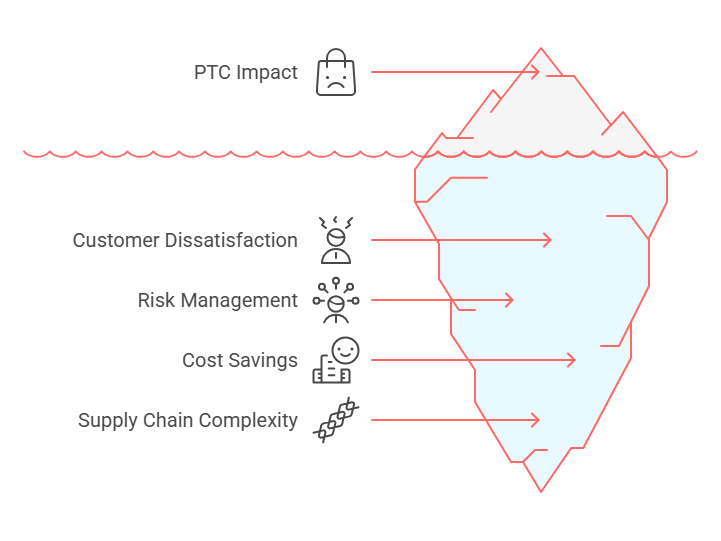
Understanding the Basics of PTC Characteristics
Defining Pass Through Characteristics in a Manufacturing Context
PTCs are defined as product or process features/dimensions that, once passed to the next operation, cannot be verified/inspected without destructive testing or rework method.
How PTC Characteristics is different from Critical, Major, and Minor Characteristics
Critical or major characteristics, which are defined based on their impact on product or assembly function, safety, or regulation point, but PTCs are categorized based on their inspectability.
A minor characteristic can be a PTC if it cannot be verified later.

The Lifecycle of a PTC Characteristics: From Design to Final Delivery
PTCs often originate from design intention and cascade to downline in process planning, tooling decisions, and operator training.
Now the PTCs should be controlled from design release to customer handover through all process operation as a complete quality pipeline. Then and then only you can check the effectiveness of implementation.
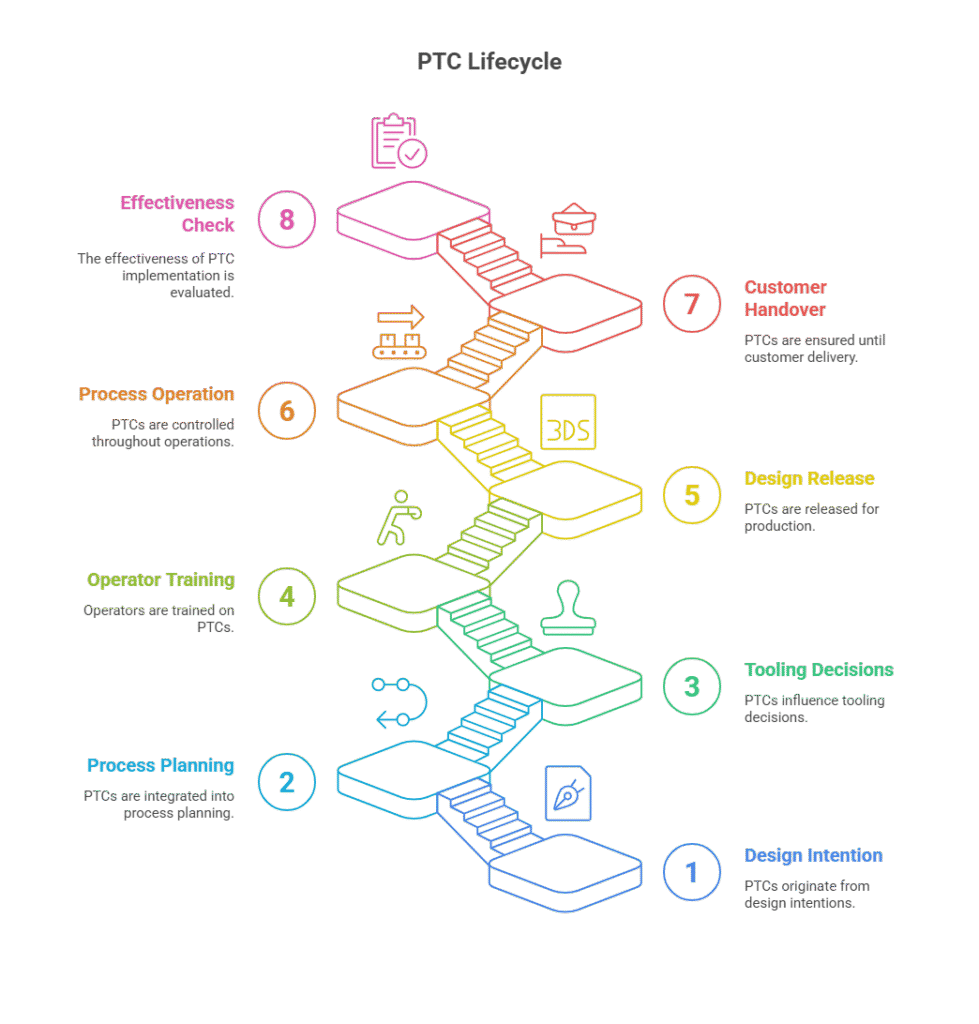
Why PTC Characteristics Matter in Manufacturing Quality
In a competitive world, cost is the major factor where every organization is struggling with. Therefore, many methodologies are being used by organization such as lean manufacturing, just-in-time, six-sigma and many more to achieve good quality product.
But the characteristics which are not re-inspectable is a real challenge. It can lead to final product failure without knowing that its child component is the issue.
This situation leads to customer claim, safety incidence, warranty, field failures and recall complaints cause customer dissatisfaction.
To ensure all this could not happen, PTCs are important to identify and maintain in your manufacturing processes.

The Role of PTC Characteristics in Customer Satisfaction and Risk Management
Customer satisfaction is not just about the visual aspect but it is primarily depend on functional and performance of your product. And these PTCs are usually link to some critical functional requirement such as sealing surfaces, safety features, or assembly fitment.
Identifying and controlling PTCs help to reduce chances of these functional failures and risk mitigation point of view.
Why PTC Characteristics Are High Risk
Hidden Defects: The Real Threat of Uncontrolled PTCs
A defect in a PTC is retained and dormant until the product is use in the field. This lack of visibility leads to minor defect into catastrophic failures, this makes PTCs a risk multiplier.
The Cost Impact of Ignoring PTC Characteristics
Beyond direct rework or warranty costs, PTC failures can create many effects, such as loss of customer confidence, audit nonconformities, and increased inspection costs.
These control measures demand resources and investment in your process control to avoid additional cost impact due to failures.
Where PTC Characteristics Show Up?
Common Areas in Manufacturing Where PTCs Are Found
PTCs frequently generates in machining, welding, painting, sealing, and electronic soldering processes.
For example, a surface finish is important or critical for good sealing function but may not be inspectable once an assembly step is completed.
Similarly, internal weld quality becomes not accessible after components are joined together.
Examples of PTCs in Automotive, Aerospace, and Electronics
In automotive, valve seat depth in engine heads, weld penetration in crash-relevant components, and alignment of airbags are classic example of PTCs.
Aerospace, the torque applied to fasteners in confined assemblies or bonding quality of composite structures are considered into this category.
In electronics, solder joint quality hidden under chips post-assembly is a good example.

Supplier-to-Customer Flow: How PTCs Travel Through the Chain
PTCs can originate at a supplier and remain undetected until final assembly by the OEM. This makes poor and critical traceability and communication. Suppliers must identify and control these PTCs with written communication to customer.
This helps to maintain consistency throughout supply chain.
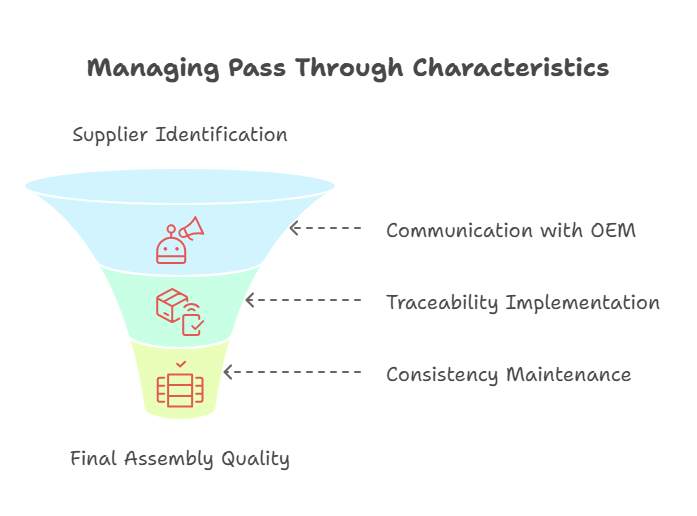
Identifying PTC Characteristics in Your Processes
How to Detect PTCs During Product and Process Design
During design reviews, every dimension or feature must cross check with a question, whether a feature can be rechecked after the next process step. If not, it should be mark as a PTC. Early identification make sure the proper control planning and avoids last-minute failure.
Cross-Functional Collaboration for Identifying PTCs
Involving design engineers, quality engineers, production leads, and even suppliers helps in PTCs identification process early. Cross-functional design reviews are help to mapping those features easily.
Using DFMEA and PFMEA to Spot PTCs Early
Failure Mode and Effects Analysis (FMEA) provides a structured approach to identify PTCs. If a failure mode cannot be detected downstream or its detection ranking is high, it’s likely a PTC. Add this insight into your control plan as a FMEA output.
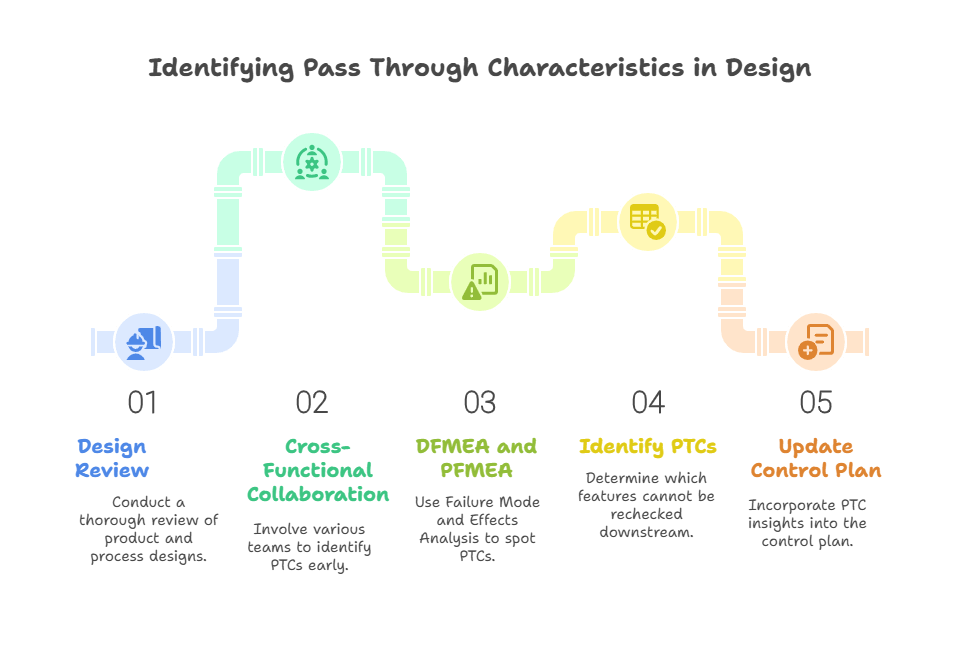
How to Control and Monitor PTC Characteristics
1. Process Controls and Visual Management for PTCs
Operators should have some immediate, simple sign or visual in process check step to identify those PTCs. Color-coded tools, gauges with go/no-go limits, and digital poka-yoke devices used in manufacturing process to easily control the pass-through characteristics.
2. Control Plan Strategies for PTC Monitoring
PTCs should be clearly mentioned in the control plan with control method and reaction plan with relevant escalation points. Process flow diagrams is one tool to align pass through characteristics checkpoints to prevents any gaps.
3. Inline Inspection vs. Final Audit for PTC Assurance
In-process inspection: PTCs must control and inspected at the time of process operation. Final product audits are not effective because the characteristic is no longer visible or measurable at this stage.
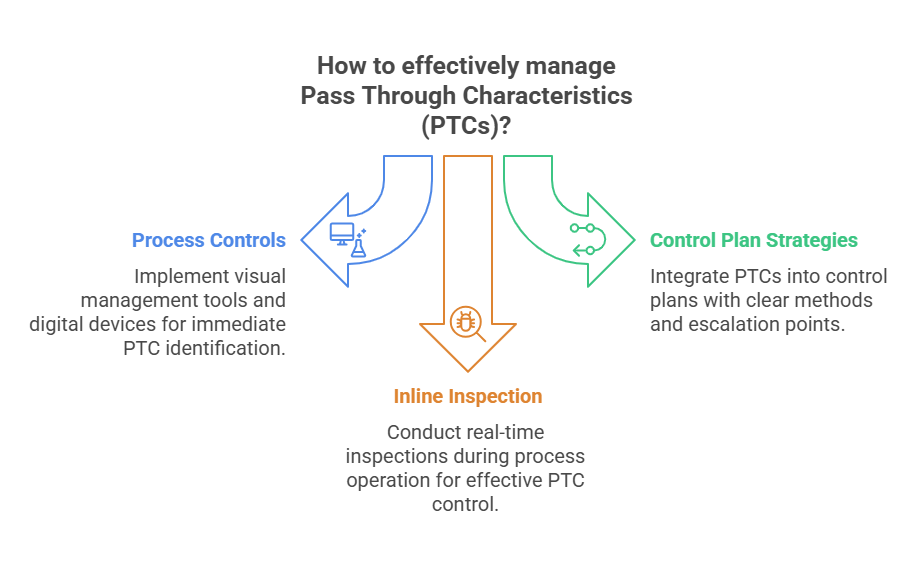
Therefore, real-time verification using in-process inspection and error-proofing methods must be in place in your operations.
Best Practices for Managing PTC Characteristics
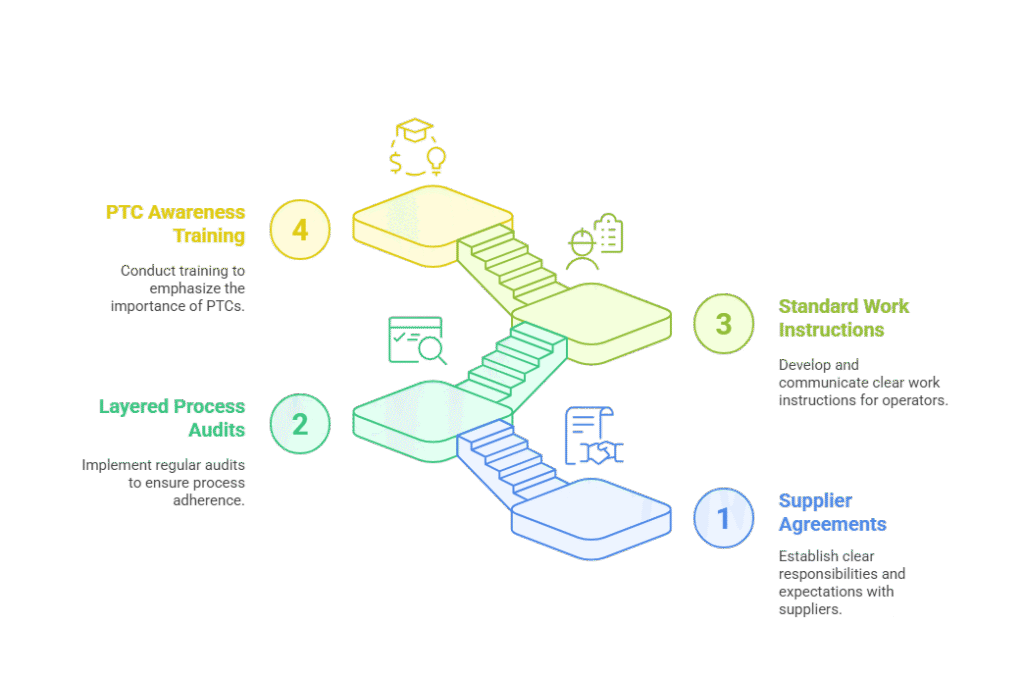
Supplier Quality Agreements That Address PTCs
PTCs should be mentioned in supplier quality agreements. Define proper responsibilities, control methods, and reaction plan. This will make sure all parties are aligned on expectations and accountability on agreed pass through characteristics.
Role of Layered Process Audits in PTC Control
LPAs (Layered Process Audits) are helping to check the process adherence. By regularly auditing your high-risk operations, which including PTC characteristics checkpoints, every organization should create a culture of accountability to maintain this discipline.
Standard Work Instructions and PTC Awareness Training
Operators must be aware of PTCs and the importance of every step related to them. Visual control, checking aids, and on-the-job training help to provide seriousness of PTC management to every operator.
Documenting and Communicating PTC Characteristics
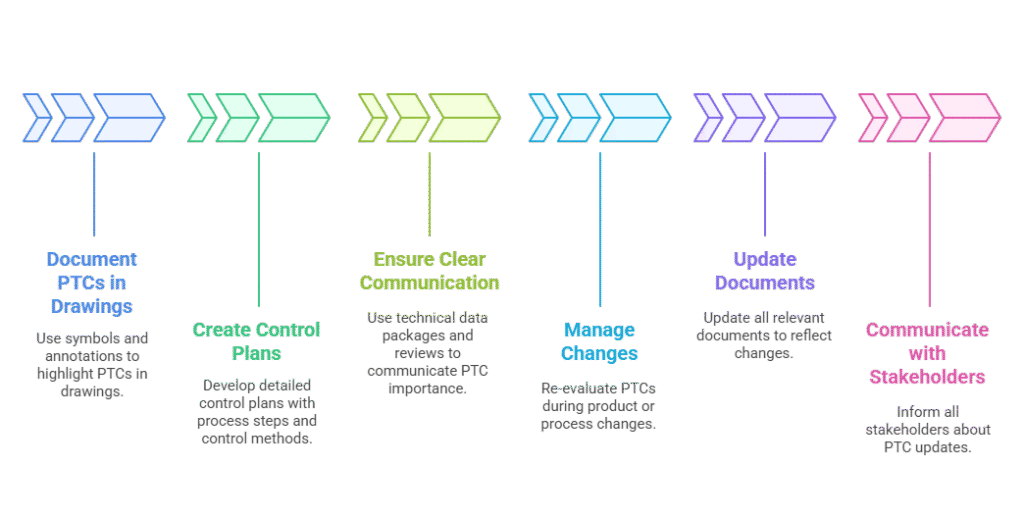
How to Document PTCs in Drawings and Control Plans
Drawings should include clear visual system such as symbols or annotations to highlight PTCs. Control plans document must have all details like the process step, control method, tool to be used, and reaction plan for those PTC characteristics.
Ensuring Clear Communication Across the Supply Chain
PTC communication should continue with the part. Use technical data packages, traceability system, supplier process sheets, and regular technical reviews to make sure suppliers and customers understand the importance and alignment of each PTC.
Change Management and PTC Updates
Any product or process change within organization or by the customer possibly impact on the PTCs. Weather there is addition or deletion of any characteristics in new change. Therefore, it is important to re-evaluate those characteristics again. Update all relevant documents and communicate all stakeholders to avoid gaps.
Real-World Examples and Case Studies
Case Study: A PTC Failure and What It Cost
An automotive manufacturing supplier failed to properly seal a transmission component. Seal quality check was the PTC and therefore it is not able to detect downstream. This failure result as recall cost. The customer will pay a millions of cost to recall and fix this issue.
Case Study: Successful PTC Control in a Tier-1 Supplier
A Tier-1 supplier implemented a real-time digital poka-yoke devices to check and verify torque on fasteners which is a PTC in their system.
As a result, customer complaints reduced by 80% and increase their customer satisfaction by improvement in their audit scores.
Challenges in managing PTC characteristics
Overlooking PTCs During APQP and PPAP
If PTCs aren’t identified in Advanced Product Quality Planning or during the PPAP process, they may remain not controllable until becomes a big failure occurrence.
Early detection is always a non-negotiable topic.
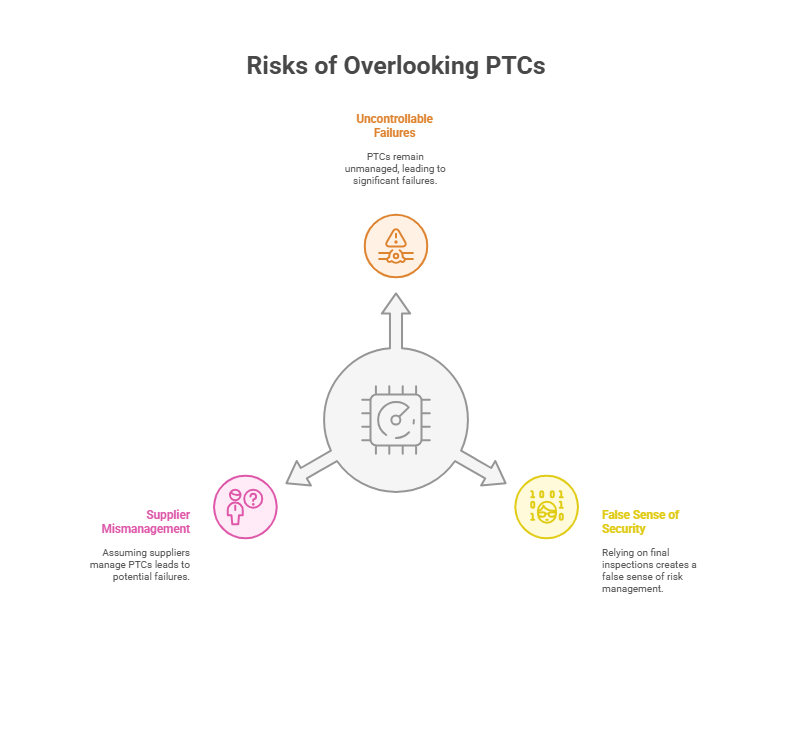
Relying Too Much on Final Inspections
Final inspection is not a safety net for PTCs. It creates a false sense of risk management. The real defense lies in robust, upstream process control where the actual PTCs are created.
Failing to address PTC Awareness to Suppliers
You should not assume that your supplier wise going to manage all PTCs. It is too risky. You should maintain a proper documentation, training, communication and agreement with supplier to control those PTCs at their end to avoid future failures.
Future of PTC Management in Quality Systems
Digital Tools and Software for PTC Tracking
Manufacturing Execution Systems (MES) and digital quality platforms can highlight flag, track, and record PTC-related operations in real time condition.
These tools enhance visibility and traceability across product supply chain.
AI and Machine Learning for Predictive PTC Control
AI models can predict PTC failure trends by analyzing process patterns in operator behavior, machine data, and inspection records. Predictive alerts allow intervention in systems to avoid cause of a non-conformance or failure.
Integration of PTCs into Industry 4.0 and Smart Manufacturing
Smart factories comes with robot systems, integrate sensors, IoT, and digital twins to control PTCs automatically.
These technologies has a self-correcting ecosystem, where PTCs are not only monitored and analyze but it also continuously optimized.
Conclusion
Final Thoughts on the Importance of PTCs
PTCs represent a silent yet potential risk in manufacturing. They need early detection, disciplined control, and constant communication to prevent costly failures/defects.
Action Steps for Strengthening PTC Control in Your Process
Map your process steps, find-out un-inspectable features, add controls at the source, and train every stakeholder involved in creation of those PTCs.
Long-Term Benefits of a PTC-Focused Quality Culture
Organizations that manage PTCs effectively can see a significantly lower warranty claims, improved customer trust, and enhanced operational efficiency. Over time, this shows a reputed organization having a good resilient quality culture with built-in immunity system on failure risk.

